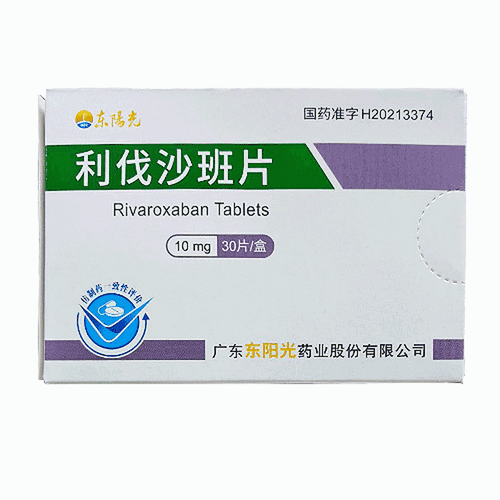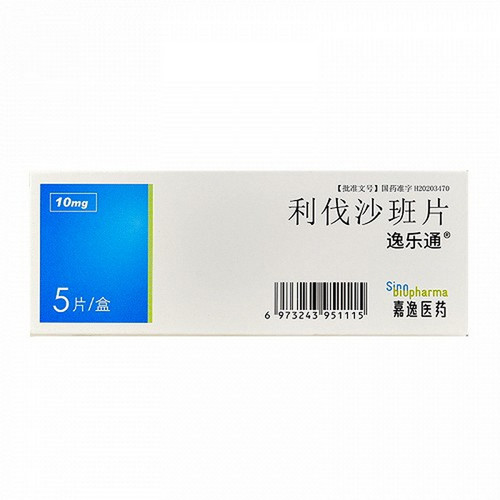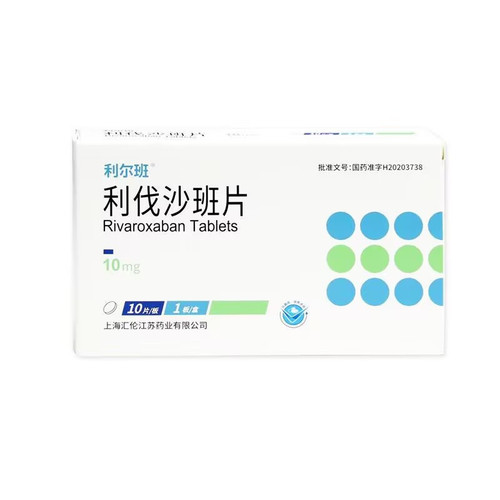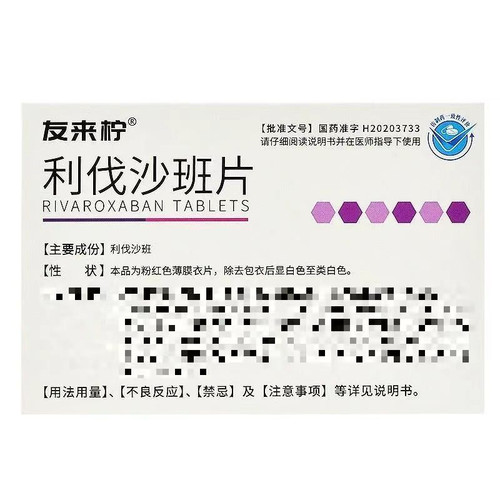Product Overview
[Drug Name]
Generic Name: Rivaroxaban Tablets
Trade Name: Huayito Rivaroxaban Tablets 10mg x 30 Tablets
[Main Ingredients]
Main ingredient: Rivaroxaban.
[Appearance]
This product is a round, light pink, biconvex coated tablet engraved with "O55" on one side and "S" on the other side.
[Indications/Main Functions]
1. For the prevention of venous thrombosis (VTE) in adult patients undergoing elective hip or knee replacement surgery. 2. For the treatment of venous thrombosis (DVT) in adults to reduce the risk of DVT recurrence and pulmonary embolism (PE) after acute DVT. 3. For the reduction of the risk of stroke and systemic embolism in adult patients with non-valvular atrial fibrillation and one or more risk factors (e.g., congestive heart failure, hypertension, age ≥75 years, diabetes, history of stroke or transient ischemic attack).
[Specifications]
10mg*30 tablets
[Dosage and Administration]
1. The recommended dose is 10mg of rivaroxaban taken orally once daily. If wound bleeding has stopped, the first dose should be taken between 6 and 10 hours after surgery. The duration of treatment depends on each patient's risk of venous thromboembolism, which is determined by the type of orthopedic surgery they undergo. 2. For patients undergoing major hip surgery, a 5-week treatment course is recommended. For patients undergoing major knee surgery, a 2-week treatment course is recommended. If a dose is missed, the patient should immediately take rivaroxaban and continue taking it once daily the following day. Patients can take rivaroxaban with or without meals.
[Adverse Reactions]
The safety of rivaroxaban 10 mg was evaluated in three Phase 2 studies, involving a total of 4,571 patients undergoing major lower extremity orthopedic surgery (total hip replacement or total knee replacement) who received rivaroxaban for up to 39 days. Approximately 14% of treated patients experienced adverse reactions. Bleeding and anemia occurred in approximately 3.3% and 1% of patients, respectively. Other common adverse reactions included nausea, increased GGT, and elevated transaminases. Adverse reactions should be interpreted in the context of the procedure. Due to its pharmacological mode of action, rivaroxaban may increase the risk of occult or overt bleeding in some tissues or organs, potentially leading to post-hemorrhagic anemia. Signs, symptoms, and severity of bleeding (including potential fatal outcomes) may vary depending on the location, degree, or extent of bleeding. The risk of bleeding may be increased in certain patient populations, such as those with uncontrolled severe arterial hypertension and/or those taking concomitant medications that affect hemostasis. Hemorrhagic complications may manifest as weakness, asthenia, pallor, dizziness, headache, or unexplained swelling. Therefore, the possibility of bleeding should be considered when evaluating patients receiving anticoagulants. Table 1 below lists adverse reactions from three Phase III studies by system organ class (MedDRA) and frequency. Frequency definitions are as follows: Common: ≥1/100 to <1/10. Uncommon: ≥1/1,000 to <1/100. Rare: ≥1/10,000 to <1/1,000. Unknown: No estimate can be made based on available data.
[Contraindications]
Rivaroxaban is contraindicated in the following patients: 1. Patients with hypersensitivity to rivaroxaban or any of the excipients in the tablets. 2. Patients with clinically significant active bleeding. 3. Patients with liver disease with coagulation abnormalities and a clinically relevant risk of bleeding. 4. Pregnant and lactating women.
[Drug Interactions]
CYP3A4 and P-gp Inhibitors: Coadministration of rivaroxaban with ketoconazole (400 mg once daily [OD]) or ritonavir (600 mg twice daily [BID]) increased the mean AUC of rivaroxaban by 2.6-fold/2.5-fold and the mean Cmax of rivaroxaban by 1.7-fold/1.6-fold, significantly enhancing drug efficacy and potentially increasing the risk of bleeding. Therefore, coadministration of rivaroxaban tablets with azole antifungals (such as ketoconazole, itraconazole, voriconazole, and posaconazole) or systemic HIV protease inhibitors is not recommended. These active substances are potent inhibitors of CYP3A4 and P-gp. Fluconazole is expected to have a minimal effect on rivaroxaban plasma concentrations, and coadministration with caution is recommended. Strong inhibitors of either of rivaroxaban's two elimination pathways (CYP3A4 or P-gp) will slightly increase rivaroxaban plasma concentrations. For example, clarithromycin (500 mg twice daily), considered a strong CYP3A4 inhibitor and a moderate P-gp inhibitor, increased the mean AUC of rivaroxaban by 1.5-fold and Cmax by 1.4-fold. These increases are not considered clinically relevant. Erythrotoxin (500 mg three times daily), a moderate inhibitor of CYP3A4 and P-gp, increased the mean AUC and Cmax of rivaroxaban by 1.3-fold. These increases are not considered clinically relevant. The combined use of enoxaparin (40 mg, single dose) and rivaroxaban (10 mg, single dose) as an anticoagulant has an additive effect on anti-factor Xa activity, but no additive effect on coagulation tests (PT, aPTT). Enoxaparin does not affect the pharmacokinetics of rivaroxaban. Patients receiving any other concomitant anticoagulant therapy should exercise caution due to the increased risk of bleeding. Nonsteroidal anti-inflammatory drugs/platelet aggregation inhibitors: No clinically significant prolongation of bleeding time was observed with the coadministration of rivaroxaban and 500 mg of naproxen. However, a more pronounced pharmacodynamic effect may occur in some individuals. No clinically significant pharmacokinetic or pharmacodynamic interactions were observed with the coadministration of rivaroxaban and 500 mg of acetylsalicylic acid. Clopidogrel (300 mg loading dose followed by 75 mg maintenance dose) did not demonstrate a pharmacokinetic interaction, but a related prolongation of bleeding time was observed in a subgroup of patients, which was not associated with platelet aggregation, P-selectin, or GPIb/α receptor levels. When patients taking rivaroxaban are taking nonsteroidal anti-inflammatory drugs (including acetylsalicylic acid) and platelet aggregation inhibitors CYP3A4 and P-gp, the mean AUC of rivaroxaban increased by 2.6-fold and 2.5-fold, and the mean Cmax of rivaroxaban increased by 1.7-fold and 1.6-fold, respectively, when rivaroxaban is coadministered with ketoconazole (400 mg once daily [od]) or ritonavir (600 mg twice daily [bid]). This significantly increases drug efficacy and may lead to an increased risk of bleeding. Therefore, coadministration of rivaroxaban with azole antifungals (such as ketoconazole, itraconazole, voriconazole, and posaconazole) or systemic HIV protease inhibitors is not recommended. These active substances are potent inhibitors of CYP3A4 and P-gp. Fluconazole is expected to have a minimal effect on rivaroxaban plasma concentrations, and coadministration with caution is recommended. Strong inhibitors of either of rivaroxaban's two elimination pathways (CYP3A4 or P-gp) may slightly increase rivaroxaban plasma concentrations. For example, clarithromycin (500 mg twice daily), considered a strong CYP3A4 inhibitor and a moderate P-gp inhibitor, increased the mean AUC of rivaroxaban by 1.5-fold and Cmax by 1.4-fold. These increases are not considered clinically relevant. Erythromycin (500 mg three times daily), a moderate inhibitor of CYP3A4 and P-gp, increased the mean AUC and Cmax of rivaroxaban by 1.3-fold. These increases are not considered clinically relevant. The coadministration of enoxaparin (40 mg, single dose) and rivaroxaban (10 mg, single dose) with anticoagulants has an additive effect on factor Xa activity, but no additive effect on coagulation tests (PT, aPTT). Enoxaparin does not affect the pharmacokinetics of rivaroxaban. Patients receiving any other concomitant anticoagulant therapy should exercise caution due to the increased risk of bleeding. Nonsteroidal anti-inflammatory drugs/platelet aggregation inhibitors: No clinically relevant prolongation of bleeding time was observed with the coadministration of rivaroxaban and 500 mg of naproxen. However, a more pronounced pharmacodynamic effect may occur in some individuals. No clinically significant pharmacokinetic or pharmacodynamic interaction was observed with the coadministration of rivaroxaban and 500 mg of acetylsalicylic acid. Clopidogrel (300 mg loading dose followed by 75 mg maintenance dose) did not demonstrate a pharmacokinetic interaction, but an associated prolongation of bleeding time was observed in a subset of patients, independent of platelet aggregation, P-selectin, or GPIb/шa receptor levels. Caution should be exercised when patients taking rivaroxaban are taking concomitant nonsteroidal anti-inflammatory drugs (including acetylsalicylic acid) and platelet aggregation inhibitors, as these drugs generally increase the risk of bleeding. Coadministration of rivaroxaban with the strong CYP3A4 inducer rifampicin decreased the mean rivaroxaban AUC by approximately 50%, with a corresponding decrease in efficacy. Coadministration of rivaroxaban with other strong CYP3A4 inducers (e.g., phenytoin, carbamazepine, phenobarbital, or St. John's wort) may also reduce rivaroxaban plasma concentrations. Caution should be exercised when coadministering strong CYP3A4 inducers. No clinically significant pharmacokinetic or pharmacodynamic interactions were observed with other concomitant medications: rivaroxaban has neither inhibitory nor inductive effects on any major CYP isoform (e.g., CYP3A4). No clinically significant interactions with food have been observed. As expected, coagulation parameters (e.g., PT, aPTT, HepTest) are affected by rivaroxaban's mode of action. Caution should be exercised when coadministering rivaroxaban with CYP3A4 inhibitors, as these drugs generally increase the risk of bleeding. Coadministration of rivaroxaban with rifampin, a strong CYP3A4 inducer, decreased the mean AUC of rivaroxaban by approximately 50%, with a corresponding decrease in efficacy. Coadministration of rivaroxaban with other strong CYP3A4 inducers (e.g., phenytoin, carbamazepine, phenobarbital, or St. John's wort) may also increase the risk of bleeding. Coadministration of rivaroxaban with ketoconazole (400 mg once daily [OD]) or ritonavir (600 mg twice daily [BID]) increased the mean AUC of rivaroxaban by 2.6-fold and 2.5-fold, and the mean Cmax of rivaroxaban by 1.7-fold and 1.6-fold, with a significant increase in efficacy, potentially leading to an increased risk of bleeding. Therefore, coadministration of rivaroxaban with azole antifungals (such as ketoconazole, itraconazole, voriconazole, and posaconazole) or systemic HIV protease inhibitors is not recommended. These active substances are potent inhibitors of CYP3A4 and P-gp. Fluconazole is expected to have a minimal effect on rivaroxaban plasma concentrations, and coadministration with caution is advisable. Strong inhibitors of either of rivaroxaban's two elimination pathways (CYP3A4 or P-gp) will slightly increase rivaroxaban plasma concentrations. For example, clarithromycin (500 mg twice daily), considered a strong CYP3A4 inhibitor and moderate P-gp inhibitor, increased the mean rivaroxaban AUC by 1.5-fold and Cmax by 1.4-fold. These increases are not considered clinically relevant. Erythromycin (500 mg three times daily), a moderate CYP3A4 and P-gp inhibitor, increased the mean rivaroxaban AUC and Cmax by 1.3-fold. These increases are not considered clinically relevant. The combined use of enoxaparin (40 mg, single dose) and rivaroxaban (10 mg, single dose) with anticoagulants has an additive effect on anti-factor Xa activity, but no additive effect on coagulation tests (PT, aPTT). Enoxaparin does not affect the pharmacokinetics of rivaroxaban. Caution should be exercised if patients are concurrently receiving any other anticoagulant due to the increased risk of bleeding. Nonsteroidal anti-inflammatory drugs/platelet aggregation inhibitors: No clinically significant prolongation of bleeding time was observed with the combined use of rivaroxaban and 500 mg of naproxen. However, a more pronounced pharmacodynamic effect may occur in some individuals. No clinically significant pharmacokinetic or pharmacodynamic interactions were observed with the combined use of rivaroxaban and 500 mg of acetylsalicylic acid. Clopidogrel (300 mg loading dose followed by 75 mg maintenance dose) did not show a pharmacokinetic interaction, but a related prolongation of bleeding time was observed in a subgroup of patients, which was not related to platelet aggregation, P-selectin, or GPIb/шa receptor levels. Caution should be exercised when patients taking rivaroxaban are taking concomitant nonsteroidal anti-inflammatory drugs (NSAIDs), including acetylsalicylic acid and platelet aggregation inhibitors, as these drugs generally increase the risk of bleeding. CYP3A4 Inducers: Coadministration of rivaroxaban with the strong CYP3A4 inducer rifampicin decreased the mean rivaroxaban AUC by approximately 50%, with a parallel decrease in efficacy. Coadministration of rivaroxaban with other strong CYP3A4 inducers (e.g., phenytoin, carbamazepine, phenobarbital, or St. John's wort) may also decrease rivaroxaban plasma concentrations. Caution should be exercised when coadministering strong CYP3A4 inducers. Other Concomitant Use: No clinically significant pharmacokinetic or pharmacodynamic interactions were observed when rivaroxaban was coadministered with midazolam (CYP3A4 substrate), digoxin (P-gp substrate), or atorvastatin (CYP3A4 and P-gp substrate). Rivaroxaban has no significant effect on the activity of any major CYP isoform (e.g., CYP 3A4) has neither an inhibitory nor an inducing effect. No clinically significant interactions with food have been observed. Laboratory parameters, as expected, show that coagulation parameters (e.g., PT, aPTT, HepTest) are affected by rivaroxaban's mode of action. Rivaroxaban plasma concentrations decreased. Caution should be exercised when coadministered with strong CYP3A4 inducers. Other Concomitant Medication: No clinically significant pharmacokinetic or pharmacodynamic interactions have been observed with the coadministration of rivaroxaban with midazolam (CYP3A4 substrate), digoxin (P-gp substrate), or atorvastatin (CYP3A4 and P-gp substrates). Rivaroxaban has neither an inhibitory nor an inducing effect on any major CYP isoform (e.g., CYP3A4). No clinically significant interactions with food have been observed. Laboratory parameters, as expected, show that coagulation parameters (e.g., PT, aPTT, HepTest) are affected by rivaroxaban's mode of action.
[Precautions]
1. Bleeding Risk: As detailed below, some subgroups of patients are at increased risk of bleeding. Following initiation of treatment, these patients should be closely monitored for signs of bleeding complications. This can be achieved through regular physical examinations, close monitoring of surgical wound drainage, and periodic hemoglobin measurement. Any unexplained decrease in hemoglobin or blood pressure should prompt investigation for the source of bleeding.
2. Renal Impairment: In patients with severe renal impairment (creatinine clearance <30 mL/min), rivaroxaban plasma concentrations may be significantly elevated, leading to an increased risk of bleeding. Rivaroxaban is not recommended for patients with a creatinine clearance <15 mL/min. Rivaroxaban should be used with caution in patients with a creatinine clearance of 15-29 mL/min. Rivaroxaban should be used with caution in patients with moderate renal impairment (creatinine clearance 30-49 mL/min) when used concomitantly with other medications that may increase the plasma concentration of rivaroxaban tablets.
3. Liver damage: In patients with cirrhosis and moderate liver damage (Child Pugh B class), rivaroxaban blood concentrations may increase significantly, leading to an increased risk of bleeding. Rivaroxaban is contraindicated in patients with liver disease accompanied by coagulation abnormalities and clinically relevant bleeding risks. For patients with cirrhosis and moderate liver damage (Child Pugh B class), rivaroxaban can be used with caution if there is no coagulation abnormality.
4. Interactions with other drugs: In the case of azole-antifungal agents (such as ketoconazole, itraconazole, voriconazole and posaconazole).
[Pharmacology and Toxicology]
1. Pharmacological action (1) Rivaroxaban is a highly selective oral drug that directly inhibits factor Xa. By inhibiting factor Xa, it can interrupt the intrinsic and extrinsic pathways of the coagulation cascade, inhibiting the generation of thrombin and thrombosis. Rivaroxaban does not inhibit thrombin (activated factor I) and has not been shown to have an effect on platelets. (2) A dose-dependent inhibitory effect of rivaroxaban on factor Xa activity was observed in humans. The effect of rivaroxaban on prothrombin time (PT) is dose-dependent and closely correlates with plasma concentrations when measured with NeopLastin® (correlation coefficient 0.98). Different results may be obtained using other reagents. The PT should be read within seconds because the international normalized ratio (INR) is only calibrated and validated for coumarins and cannot be used for other anticoagulants. In patients undergoing major orthopedic surgery, 2-4 hours after tablet administration (when the effect is strongest), the PT at the 5/95th percentile is 13-25 seconds (NeopLastin®) (pre-operative baseline value is 12-15 seconds). (3) Prolongation of the activated partial thromboplastin time (aPTT) and HepTest is also dose-dependent; however, their use in evaluating the efficacy of rivaroxaban is not recommended. Rivaroxaban also has an effect on antagonistic factor Xa activity; however, no calibration standard is currently available. Coagulation parameters do not need to be monitored during routine clinical use of rivaroxaban. 2. Toxicology studies (1) Based on traditional safety pharmacology, single-dose toxicity, phototoxicity, and genotoxicity studies, nonclinical data indicate no specific hazard to humans. The effects observed in repeated-dose toxicity studies were primarily due to the extended pharmacodynamic activity of rivaroxaban. In rats, elevated IgG and IgA plasma concentrations were observed at clinically relevant plasma concentrations. (2) Animal studies have shown reproductive toxicity related to the pharmacological mechanism of action of rivaroxaban (e.g., bleeding complications). Embryo-fetal toxicity (post-implantation loss, delayed/progressive ossification, multiple pale spots on the liver) and increased incidence of common malformations and placental changes were observed at clinically relevant plasma concentrations. In prenatal and postnatal studies in rats, reduced offspring viability was observed at maternally toxic doses.








